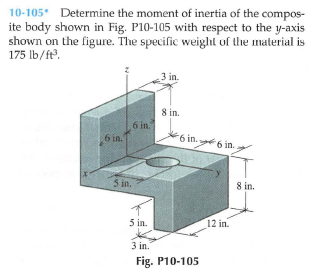10-105 Determine the moment of inertia of the compos- ite body shown in Fig. P10-105 with respect to the y-axis shown on the figure. The specific weiglıt of the material is 175 lb/ft. 3 in. 8 in. 6 in. 6 in. 6 in. . 6 in. 5 in. 8 in. 5 in. 12 in. 3 in. Fig. P10-105

Moment of inertia it determines the torque needed for a desired angular acceleration about rotational axis. it depends on the mass of the body chosen and the axis in consideration. Mathematically moment of inertia I is defined as the ratio of the net angular momentum L of a system to its angular velocity ω around a principal axis that is,
Parallel Axes Theorem:
The moment of inertia of a body about an axis parallel to the body passing through its center is equal to the sum of moment of inertia of body about the axis passing through the center and product of mass of the body times the square of distance between the two axes.
Now the given problem is of a composite area. For such a system to find moment of inertia around and axis we need to,
- Identify simple shaped subareas in the composite.
- Determine the distance from centroid to each of those subareas.
- Determine moment of inertia of each subarea
- Apply Parallel Axes theorem on each subarea
- Add or subtract (negative subareas) the moments of inertia from the last step.
.png)
The lines in section 2 shows the hole
Mass of section 1 is,
Now volume V of section1 is given by,
Now substituting in eq(1)
Now we calculate moment of inertia of section 1 along Y axis,
Now substituting,
Now volume V of section 2 is given by,
Now substituting in eq(1)
Now we calculate moment of inertia of section 2 along Y axis,
Now substituting,
Step by step
Solved in 8 steps with 1 images
